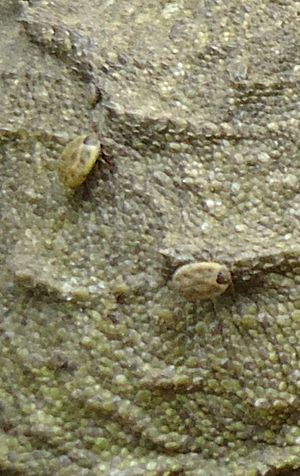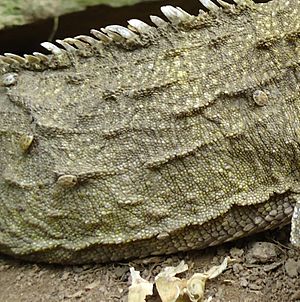Tuatara tick facts for kids
Quick facts for kids Tuatara tick |
|
|---|---|
 |
|
| Amblyomma sphenodonti on a tuatara | |
| Conservation status | |
|
Invalid status (NZ TCS)
|
|
| Scientific classification | |
| Synonyms | |
|
The tuatara tick, officially known as Archaeocroton sphenodonti, is a special type of tick. It's unique because it only lives on and feeds from the tuatara, a reptile found in New Zealand.
These tiny creatures are found on only four of the twelve island groups where tuatara live. They prefer islands where many tuatara live close together. All stages of the tick's life – from tiny larvae to nymphs and adult ticks – feed only on tuatara blood. Amazingly, these ticks can live for up to a year without finding a tuatara to feed on! When tuatara are moved to new places, their ticks often disappear or become very few in number.
Contents
What is the Tuatara Tick?
Adult tuatara ticks are small, about 2 millimetres (0.079 in) long, and look almost round. They are light brown in color. The first time scientists described this tick was in 1943. This was done by a scientist named Lionel Jack Dumbleton.
The very first male tick specimen used for this description was found on Stephens Island. It was collected in January 1922. This important specimen is now kept safe in the New Zealand Arthropod Collection.
Where Do Tuatara Ticks Live?
Just like their host, the tuatara, these ticks live on islands off the coast of New Zealand. You can find them near the North Island and South Island. However, they are only found on four specific island groups. These are the Mercury and Aldermen Islands near the North Island. They also live on Stephens Island and the Trios in Cook Strait.
Islands with lots of tuatara usually have more ticks. This is because the ticks don't move around much on their own. It's easier for them to find a host when many tuatara are nearby. If there are fewer tuatara, or their numbers change a lot, it's harder for the ticks to spread.
Tuatara Tick Life Cycle
The tuatara tick has a three-stage life cycle. All three stages need to feed on a tuatara.
- First, a female tick that has fed on blood leaves the tuatara.
- She then lays her eggs inside the tuatara's burrow.
- When the eggs hatch, tiny larvae appear. These larvae attach to a tuatara, feed, and then drop off.
- After shedding their skin, they become nymphs. The nymphs also attach to a tuatara, feed, and then drop off.
- Finally, the nymphs shed their skin again to become adult ticks.
This whole life cycle can take about two to three years to complete. Warmer temperatures can make all these stages develop faster.
How Tuatara Ticks Live
Tuatara are reptiles that live in burrows for shelter. Their ticks can spend over a year away from a tuatara. They like the damp and dark conditions found inside these burrows. This preference helps them stay in or find burrows where tuatara live.
Tuatara ticks are found on tuatara in all kinds of places. However, there are more ticks on tuatara that live in grassy areas than in forests. Tuatara ticks are most active at night, just like tuatara. Being more mobile at night helps ticks without a host find one. It also helps them avoid drying out because the air is more humid at night.
Ticks prefer to attach to certain parts of the tuatara's body. They like the back, the folds of skin on the rear legs, and the sides of the body. Once attached, they feed on the tuatara's blood. Adult ticks that haven't fed can survive for more than a year without a host.
Conservation Status
The tuatara tick is not as widespread as the tuatara itself. When tuatara have been moved to new places, the number of ticks in the new group is often much lower, or they are completely gone. Sometimes, ticks are removed from tuatara before they are moved. Other times, tuatara populations lose their ticks after being moved.
The conservation status of this tick is "relict." This means that, like the tuatara, it used to live in many more places than it does now.
See also
 In Spanish: Amblyomma sphenodonti para niños
In Spanish: Amblyomma sphenodonti para niños


